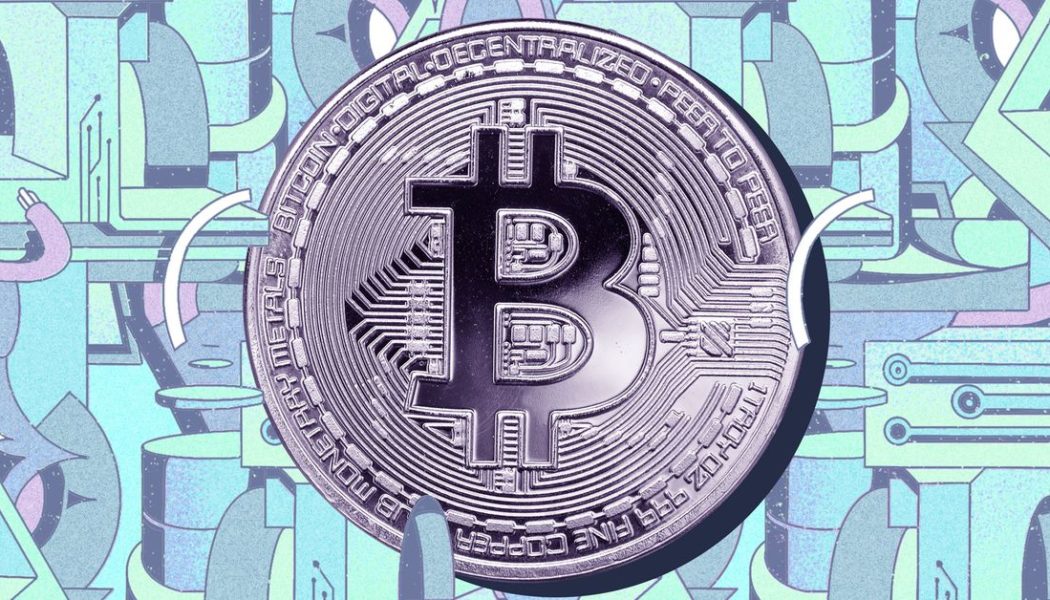/cdn.vox-cdn.com/uploads/chorus_asset/file/24273495/226437_M_Huigen_year_in_crypto.jpg)
Depending on how you look at it, this is either a cautionary tale about how small and entwined the crypto world is or a cautionary tale about employing journalists.
When CoinDesk published a blockbuster scoop on Alameda Research’s balance sheet, it also shot its own parent company in the foot. That story kicked off a series of events that led to FTX filing for bankruptcy. The amount of missing money was so big that the story breached the containment wall around crypto shenanigans and became a genuine mainstream news story, the kind my landlady asks me about. The problem for CoinDesk is that some of the money that’s locked in FTX belongs to their sister company, and that’s just adding to their parent company’s woes.
“Someone told me to look into the amount of market-making Alameda was doing on FTX, pointing out that this arrangement ‘stinks.’”
One of the basic truisms of journalism is that you don’t control what will happen after you publish. There’s no way of knowing beforehand what the audience’s reaction will be or what powerful person or people might be part of that audience. “We didn’t know it would lead to all this,” Tracy Wang, a deputy managing editor at CoinDesk, told me.
CoinDesk’s Ian Allison heard rumblings about FTX and Sam Bankman-Fried even before crypto firms started blowing up this year. “Someone told me to look into the amount of market-making Alameda was doing on FTX, pointing out that this arrangement ‘stinks,’” Allison said in an emailed statement. He also got audited financials from FTX and FTX US for 2020 and 2021, though he ultimately didn’t write a story on those. Then, in October, he had a chat with someone who indicated Alameda’s balance sheet was weaker than widely believed, and after poking around with sources, he got ahold of the balance sheet that formed the basis of his big story.
On November 2nd, Allison reported that the line between trading firm Alameda Research and exchange FTX was awfully blurry — and that a significant part of Alameda’s balance sheet consisted of FTT tokens, which were issued by FTX and gave holders a discount on FTX trades. This is sort of like discovering that a lot of Sephora’s balance sheet consists of Sephora Beauty Insider Points, the value of which is determined, primarily, by Sephora itself.
CoinDesk’s audience apparently included Changpeng “CZ” Zhao, the owner of a competitor exchange, Binance. There’s bad blood between Zhao and FTX’s Bankman-Fried — more than you’d expect for mere business rivals. Four days after the CoinDesk story about Alameda Research and FTX, Zhao announced that “due to recent revelations that have came to light, we have decided to liquidate any remaining FTT on our books.”
“I’ve been a journalist for 21 years and I’ve never had a story have this level of impact.”
Binance was sitting on a lot of FTT because it had been an early investor in FTX — and publicly posting the trade was tantamount to an assassination. (Zhao has denied this, but lol, lmao.) Zhao later signed a letter of intent to buy FTX but backed out after revealing an enormous hole in FTX’s balance sheet. FTX and all its related entities, including Alameda, filed for bankruptcy, and Bankman-Fried stepped down from his position as FTX’s CEO.
This is unusual for any story — it’s a blockbuster. “This is the proudest moment of my career,” says Michael Casey, the chief content officer at CoinDesk. “I’ve been a journalist for 21 years and I’ve never had a story have this level of impact” — not even at his previous employer, The Wall Street Journal.
This would all be pretty unremarkable outside of journalism, except for CoinDesk’s ownership.
“They’re not tweeting and negotiating by tweet.”
CoinDesk is part of holding company Digital Currency Group, or DCG, run by Barry Silbert. DCG acquired the publication in 2016 for somewhere between $500,000 and $600,000 in a move that TechCrunch reported was a stunt for “boosting the visibility” of the associated Consensus conference. (CoinDesk, which first began publishing in 2013, was founded by Shakil Khan, an investor in Bitcoin payments services company BitPay; Silbert was also an initial investor in BitPay, and DCG was already an investor in CoinDesk when it acquired the rest.)
DCG is relatively buttoned-up in terms of its investments and portfolio, insofar as it is possible to be conservative in cryptocurrency. There’s no meme capitalism here — investing through DCG’s subsidiary Grayscale Investments is a way to get involved with crypto without owning crypto directly. Grayscale’s Bitcoin Trust even has a ticker and trades over the counter, like a stock. “They’re not tweeting and negotiating by tweet,” says William Cai, the co-founder and managing partner of Wilshire Phoenix. “You feel you have real adults in the room.”
DCG was founded in 2015 and has seven subsidiaries, with their own budgets and management teams and so on. The ones we are primarily concerned with — besides CoinDesk — are Grayscale and Genesis. Grayscale is the world’s largest digital currency asset manager, and fees from Grayscale’s two largest trusts — Bitcoin and Ethereum — make up the majority of DCG’s revenue, which is projected to be about $800 million this year.
Grayscale’s Bitcoin Trust was designed to eventually become an exchange-traded fund. (There have been some issues with this, and it isn’t one yet.) It started as a product called a Delaware grantor trust and was only open to accredited investors. After partnering with over-the-counter markets, it moved from being private to having a public price quote. Shares can only be created in the private placement, but they can be traded over the counter. In 2020, Grayscale began making Securities and Exchange Commission reports on its trusts.
Until recently, the sole entity that could create shares in Grayscale was Genesis
For a crypto true believer, this is nonsense — just buy Bitcoin and put it in your cold wallet and call it a day. But for a family office, a hedge fund, or an endowment, that may not make sense, Cai says. Those types of investors may want something that’s more plug-and-play, that integrates with the tech they already have to manage their conventional investments.
Until recently, the sole entity that could create shares in Grayscale was Genesis. That changed in October.
It changed because Genesis was in pretty big trouble.
FTX is just the most recent in a year of crypto meltdowns. Back in July, a hedge fund called Three Arrows Capital went from $10 billion in assets to bankruptcy in fairly short order. 3AC started as a kind of arbitrage firm, and one of the trades it made involved Grayscale.
There was a time when shares of the Grayscale Bitcoin Trust, or GBTC, traded for more than the worth of the underlying Bitcoin. So 3AC saw an opportunity: they could deliver, let’s say, $1 million worth of Bitcoin to Grayscale and get back shares of GBTC that were worth $1.3 million on the open market. There’s a catch, though — which is that 3AC wouldn’t get those shares for a year. (That time has decreased to six months since 2020.) So 3AC was basically making a bet that the Grayscale premium would exist a year (or, near the end, six months) from their initial investment.
“Hundreds of millions, right? At the end, billions.”
And they were doing it with borrowed money. “At first, it was very hard for me to get, like, $10 million to borrow,” said 3AC co-founder Kyle Davies in an interview with podcaster and financier Hugh Hendry. But then he met Genesis. “They would go out and say, ‘We understand the trade you’re doing, we’re going to lend you a lot more than what we did before.’ Hundreds of millions, right? At the end, billions.” More than $2.3 billion, according to a bankruptcy filing in which DCG filed a claim for $1.2 billion. Genesis, it turns out, was the biggest creditor to 3AC — and DCG took over the claim.
The Grayscale premium vanished in January 2021. This was big trouble for 3AC, which by December 2020, owned more than 5 percent of the shares of GBTC. Even bigger trouble? It had bet big on the success of failed algorithmic stablecoins Luna / Terra, which blew up in May. Then, as the entire crypto market crashed, it turned out 3AC wouldn’t recover — because they’d been long Bitcoin, too.
Genesis wasn’t just doing business with 3AC. It also got hit by the collapse of crypto lender Babel Finance, and in August, then-CEO Michael Moro resigned. 1 in 5 workers at Genesis lost their jobs.
When CoinDesk landed the scoop that led to FTX’s bankruptcy, that made things even worse. Genesis has $175 million locked in FTX’s bankruptcy. It also made loans to Alameda and took the now-worthless FTT token as collateral, an anonymous source told Reuters. Genesis has been spotted by The Wall Street Journal and Bloomberg asking people for a billion dollars to shore up its business. The Journal says Genesis asking for a loan; Bloomberg says investments.
By contrast, CoinDesk is riding high right now — its page views nearly doubled from October to November. Its FTX coverage drove 5.4 million page views, or almost a third of its 17 million total that month. Allison’s scoop about the FTX balance sheet outperformed any other business articles published by a factor of 20. (Kids, this is why editors pound their desks and demand scoops.)
You can see why people might opportunistically bid on CoinDesk when its parent is vulnerable
Even as CoinDesk thrives, it’s clear that its parent company needs money one way or another. Genesis was a big deal in the crypto boom, notes Nathaniel Whittemore on his CoinDesk podcast. “At the height of the market, Genesis was moving size,” Whittemore says. In the fourth quarter of 2021, it originated $50 billion in loans and had $12.5 billion in active loans.
As of the third quarter of this year, Genesis originated only $8.4 billion and had just $2.8 billion in active loans. Of course, that was before the FTX debacle. Genesis has since hired a restructuring firm, with the goal of avoiding bankruptcy. Bankruptcy might not be so bad, though — DCG’s founder, Silbert, has a background in distressed assets.
Still, you can see why people might opportunistically bid on CoinDesk when its parent is vulnerable. CoinDesk received an unsolicited offer for a $300 million buyout, but there is no formal sales process in place. (This news was first reported by Semafor.)
That offer was too low, which might startle people who remember that Jeff Bezos bought The Washington Post for a mere $250 million. But the Post was in the red at the time and had been for years; by contrast, CoinDesk has $50 million in annual revenue. And as a trade publication, CoinDesk might be more advertiser-friendly than a company that does hard news, particularly political news.
There’s also the Consensus conference, which might struggle in crypto winter but could be a major profit center if the sector rebounds. (Associated with that is the Desk coin, which is meant to reward people who attend the conference. It can be user for, , among other things, free drinks.) CoinDesk has a crypto information business, which is used by The Wall Street Journal among others. In some ways, the publication closely resembles Bloomberg but for crypto: a data and information business where news is a component of the information. CoinDesk’s editor-in-chief Kevin Reynolds was a colleague of mine at Bloomberg, so the resemblance does not strike me as especially coincidental.
Of course, a bet on CoinDesk’s success is also a bet that the crypto industry will recover from 2022.
Everyone I spoke to at CoinDesk, whether on or off the record, wanted to emphasize that CoinDesk has editorial independence. No shit. Under what other circumstances would journalists blow up their imperiled sister company?
I found the defensiveness surprising because I am a fan of CoinDesk. There are other crypto outlets that employ journalists I respect, but I actually visit the CoinDesk front page just to see what’s up. Which is why I’m anxious about the specter of a buyout since there’s no guarantee new owners will continue to let it thrive as DCG has done. Like, what if the monsters at Alden Global Capital buy it?
CoinDesk can hire from a larger talent pool if it doesn’t ban owning crypto
Maybe the defensiveness is because CoinDesk does have some ethics policies that are different from other journalism operations. For instance, they mostly do not seek to unmask pseudonymous accounts in crypto by trying to match them with real-world identities. I understand this primarily as a practical matter — I’ve had people at crypto conferences literally run away after I told them I was a journalist. But it runs contrary to the usual practices of financial journalism.
CoinDesk’s philosophy is also the community norm, notes Casey, the company’s editorial director. Plus, crypto gets hacked a lot. “Our view is that it’s not just consistent with our community but also the era of data insecurity and breaches and the need to allow people to protect their privacy in that context,” he says. Pseudonymous accounts do have long-term reputations, Casey says.
Seems reasonable. That said, Do Kwon was pseudonymously involved with Basis Cash, a failed stablecoin, before doing Terra / Luna, which involved another failed stablecoin. CoinDesk reported his involvement after the Luna crash; the authors, Sam Kessler and Danny Nelson, were almost apologetic, assuring their audience that they didn’t take violating anonymity lightly. Casey told me he didn’t know if identifying Kwon earlier would have changed anything. He’s right, of course — the crypto community has an irritating habit of responding to news they don’t like by calling it “FUD,” slang for “fear, uncertainty, and doubt,” and then ignoring it. But I do wonder: would knowing Kwon’s track record have changed anything for 3AC?
The other unusual thing is that many of the journalists at CoinDesk own crypto. CoinDesk’s ethics policy mandates that reporters disclose on their profile pages any investments of more than $1,000. Further, “they should avoid such conflicts by minimizing their own coverage of assets or companies in which they have a financial interest, or of issues they are involved in as activists. Above all, they may never misuse our platform for personal gain.”
There are some practical matters here, too. First of all, it is useful to understand how crypto works if you cover it, and one way to do that is to trade it. But also, a lot of the people who know the most about crypto got into it because they like crypto, not journalism, and people who get both of those things are fairly thin on the ground. CoinDesk can hire from a larger talent pool if it doesn’t ban owning crypto, Casey points out. “The most important thing is not zero participation, but full disclosure,” he says.
“These journalists were getting offered not just high-level salaries but large distributions of what were then high-flying tokens.”
Besides, people who cover currency often own, for instance, dollars. Is that a conflict of interest? In Casey’s estimation, Bitcoin and Ethereum are no different.
The disclosure statement that appears at the end of articles includes the phrase: “as part of their compensation, certain CoinDesk employees, including editorial employees, may receive exposure to DCG equity in the form of stock appreciation rights, which vest over a multi-year period. CoinDesk journalists are not allowed to purchase stock outright in DCG.” This is more interesting.
It’s normal for journalists’ compensation plans to include stock options, stock appreciation rights (SARs), or other kinds of bonuses tied to their parent company. It’s just that most of us do not work for conglomerates where the other arms are financial companies that we also cover.
The SARs are a retention strategy, Casey says — not just because Bloomberg has been poaching, though Bloomberg has also been poaching, but because places such as Coinbase and Kraken were luring talent last year for in-house publications. “These journalists were getting offered not just high-level salaries but large distributions of what were then high-flying tokens,” Casey says. “So it was hard to retain people in what was already a small pool of people with the talent we need.”
CoinDesk began offering SARs in 2022. Essentially, SARs are profitable when DCG’s stock price goes up. And they take a year to vest: anyone granted SARs in 2022 can’t get the bonus until 2023 at the absolute earliest.
If DCG’s valuation is affected by Genesis’ woes, it’ll also affect any employees who accepted SAR grants. Last year, DCG was valued at $10 billion in a secondary round by investors that include SoftBank, Alphabet’s private equity arm, and Ribbit Capital, a group whose goal is to change the world of finance. If DCG is forced to raise capital to cover Genesis’ debts, that may result in a down round and a hit to the SARs. So, depending on when they choose to sell, it’s possible CoinDesk’s journalists may have hurt their own compensation packages when publishing their big scoop.
I asked Casey what stories he wished CoinDesk had about DCG. He paused for a second. “That’s a little too close to the bone,” he told me.









